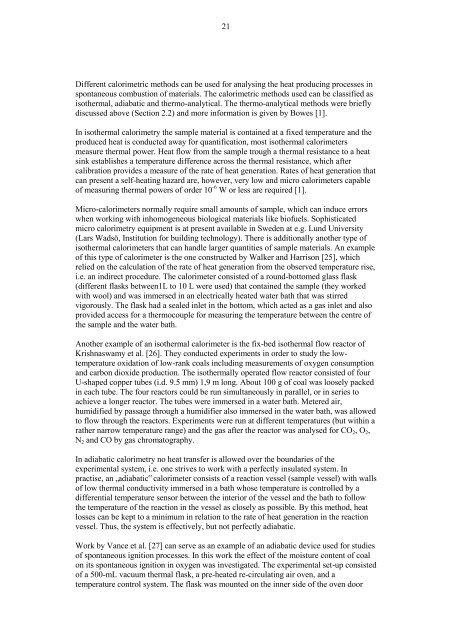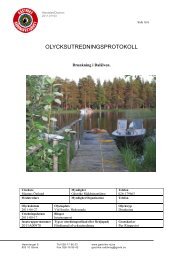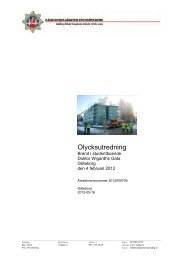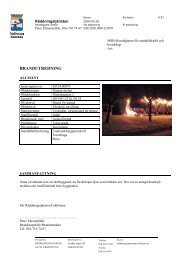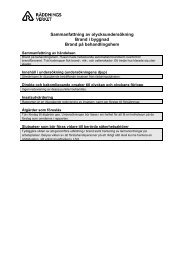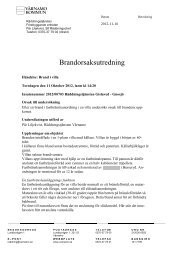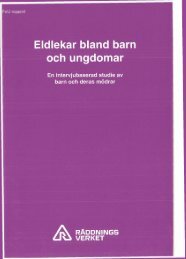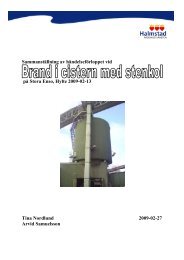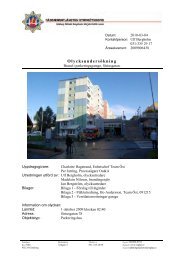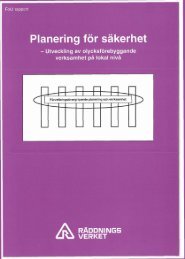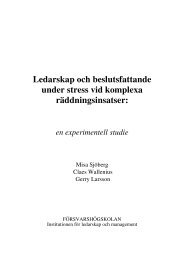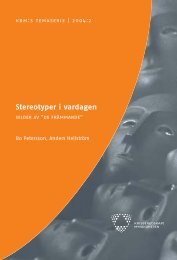Spontaneous Ignition - A Litterature Study of Experimental Methods
Spontaneous Ignition - A Litterature Study of Experimental Methods
Spontaneous Ignition - A Litterature Study of Experimental Methods
You also want an ePaper? Increase the reach of your titles
YUMPU automatically turns print PDFs into web optimized ePapers that Google loves.
21Different calorimetric methods can be used for analysing the heat producing processes inspontaneous combustion <strong>of</strong> materials. The calorimetric methods used can be classified asisothermal, adiabatic and thermo-analytical. The thermo-analytical methods were brieflydiscussed above (Section 2.2) and more information is given by Bowes [1].In isothermal calorimetry the sample material is contained at a fixed temperature and theproduced heat is conducted away for quantification, most isothermal calorimetersmeasure thermal power. Heat flow from the sample trough a thermal resistance to a heatsink establishes a temperature difference across the thermal resistance, which aftercalibration provides a measure <strong>of</strong> the rate <strong>of</strong> heat generation. Rates <strong>of</strong> heat generation thatcan present a self-heating hazard are, however, very low and micro calorimeters capable<strong>of</strong> measuring thermal powers <strong>of</strong> order 10 -6 W or less are required [1].Micro-calorimeters normally require small amounts <strong>of</strong> sample, which can induce errorswhen working with inhomogeneous biological materials like bi<strong>of</strong>uels. Sophisticatedmicro calorimetry equipment is at present available in Sweden at e.g. Lund University(Lars Wadsö, Institution for building technology). There is additionally another type <strong>of</strong>isothermal calorimeters that can handle larger quantities <strong>of</strong> sample materials. An example<strong>of</strong> this type <strong>of</strong> calorimeter is the one constructed by Walker and Harrison [25], whichrelied on the calculation <strong>of</strong> the rate <strong>of</strong> heat generation from the observed temperature rise,i.e. an indirect procedure. The calorimeter consisted <strong>of</strong> a round-bottomed glass flask(different flasks between1L to 10 L were used) that contained the sample (they workedwith wool) and was immersed in an electrically heated water bath that was stirredvigorously. The flask had a sealed inlet in the bottom, which acted as a gas inlet and alsoprovided access for a thermocouple for measuring the temperature between the centre <strong>of</strong>the sample and the water bath.Another example <strong>of</strong> an isothermal calorimeter is the fix-bed isothermal flow reactor <strong>of</strong>Krishnaswamy et al. [26]. They conducted experiments in order to study the lowtemperatureoxidation <strong>of</strong> low-rank coals including measurements <strong>of</strong> oxygen consumptionand carbon dioxide production. The isothermally operated flow reactor consisted <strong>of</strong> fourU-shaped copper tubes (i.d. 9.5 mm) 1,9 m long. About 100 g <strong>of</strong> coal was loosely packedin each tube. The four reactors could be run simultaneously in parallel, or in series toachieve a longer reactor. The tubes were immersed in a water bath. Metered air,humidified by passage through a humidifier also immersed in the water bath, was allowedto flow through the reactors. Experiments were run at different temperatures (but within arather narrow temperature range) and the gas after the reactor was analysed for CO 2 , O 2 ,N 2 and CO by gas chromatography.In adiabatic calorimetry no heat transfer is allowed over the boundaries <strong>of</strong> theexperimental system, i.e. one strives to work with a perfectly insulated system. Inpractise, an „adiabatic‟ calorimeter consists <strong>of</strong> a reaction vessel (sample vessel) with walls<strong>of</strong> low thermal conductivity immersed in a bath whose temperature is controlled by adifferential temperature sensor between the interior <strong>of</strong> the vessel and the bath to followthe temperature <strong>of</strong> the reaction in the vessel as closely as possible. By this method, heatlosses can be kept to a minimum in relation to the rate <strong>of</strong> heat generation in the reactionvessel. Thus, the system is effectively, but not perfectly adiabatic.Work by Vance et al. [27] can serve as an example <strong>of</strong> an adiabatic device used for studies<strong>of</strong> spontaneous ignition processes. In this work the effect <strong>of</strong> the moisture content <strong>of</strong> coalon its spontaneous ignition in oxygen was investigated. The experimental set-up consisted<strong>of</strong> a 500-mL vacuum thermal flask, a pre-heated re-circulating air oven, and atemperature control system. The flask was mounted on the inner side <strong>of</strong> the oven door


